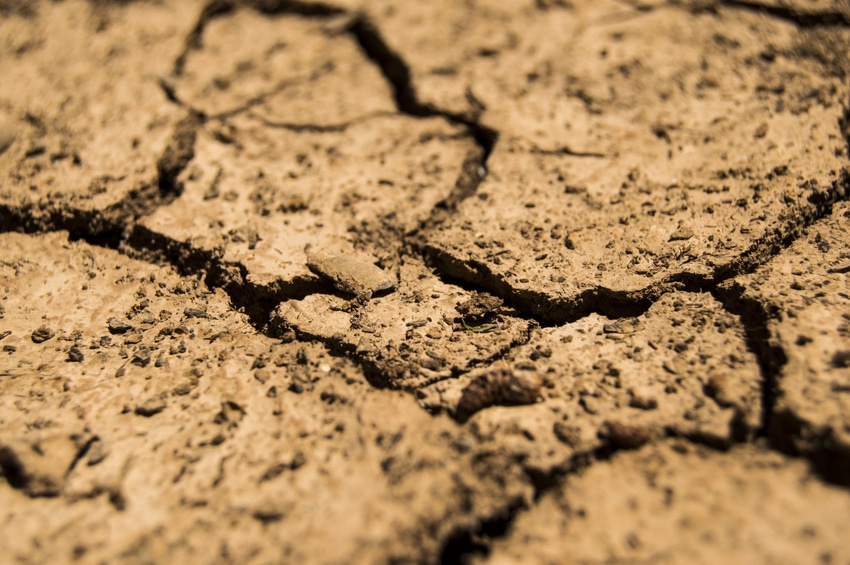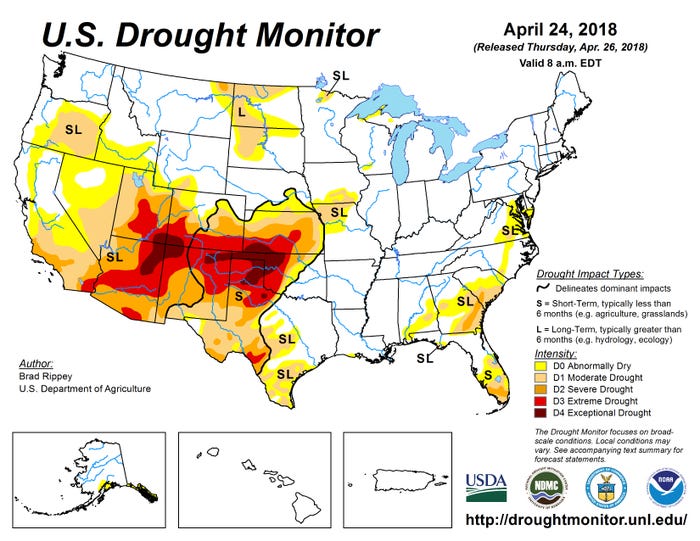Recent precipitation not enough to reduce drought without additional moisture.

The latest U.S. Drought Monitor showed rapid expansion of the area in exceptional drought (D4) to 38 million acres and another 126 million acres in extreme drought (D3) conditions. Some areas within the drought region did receive some rain over the last couple of weeks, but Oklahoma State University Extension livestock marketing specialist Derrell Peel said while it was enough to slow the expansion of drought, it was not enough to reduce drought conditions without additional moisture.
Peel pointed out that about two-thirds of the D4 area is in the Texas Panhandle; western Oklahoma, including the panhandle; and southwest Kansas.

“In this shortgrass prairie region, May is a critical period when summer forage growth begins in earnest,” he explained. “If normal forage growth is absent or significantly delayed, cattle producers will face some critical decisions rather quickly in the next few weeks. Producers need to develop drought management plans now to survive in the face of a potentially extended drought that threatens the entire growing season.”
According to Peel, one strategy is simply to hunker down, try to hold on to everything and acquire feed resources in hopes of skimping animals through the drought. However, he said there are several risks to this strategy.
“First, the ‘get by’ strategy of managing cows through a drought may simply postpone drought costs into future years by negatively impacting reproductive performance and future production. It’s important not to keep more animals than you can properly take care of,” he explained.
Another risk, Peel said, is the potential that holding animals will incur so much cost that the financial health of the business will be compromised for a long period or the economic survivability of the business is jeopardized.
Last, he explained that abusing forage resources during a drought can lead to damage that requires years to recover from and implies reduced future production to allow time for the land and forage to heal after severe use.
“A comprehensive, detailed plan will help remove as much emotion as possible and will make it easier to make tough, timely decisions and is very important as well for the short- and long-term mental and physical health of the producer and families involved,” he said.
The sooner a producer can evaluate and inventory resources, the more opportunity there will be to make decisions rather having decisions forced on them, Peel said.
“Water, in some cases, will provide a harder deadline than feed. Producers relying on surface water must calculate available water supplies and use that to determine how to allocate limited water over time," he said. "Additionally, it’s important to evaluate forage and feed resources available today, including standing forage, hay and other feed resources.”
According to Peel, a drought management plan should be based on that feed availability amount and assume no or little new forage production. “Very critical, but often overlooked, is to evaluate financial resources and realistic limits on additional costs,” he added.
Peel explained that a critical component of a drought management plan is determining when to switch from “hunker down” to an active plan that involves revising production activities. This, according to Peel, may include different production systems such as drylot production of some cattle or relocating cattle to another region.
“When animal numbers can no longer be maintained, it is important to remember that liquidation is not an all-or-nothing proposition. Make a priority list of what animals to sell and when that decision must be implemented," he suggested. "It may be helpful to determine the last core of animals that would be maintained prior to total liquidation and then work backwards to figure out what order of liquidation would get to that point, if necessary.”
Peel said it is essential to have action dates and follow the plan. He said dates can be revised as needed if conditions change, but not having dates results in emotional anguish and the temptation to “hang on for a few more days," which often results in bigger long-term consequences.
“We never know how long a drought will last, but whether it’s a few weeks or a few months or possibly many months, it’s important not only to figure out how to survive the drought but to manage for the post-drought period during the drought. At the end, business survival is an economic question, not a just a matter of how many cattle we can hold onto for another two weeks, … or a month … or whatever,” Peel said.
About the Author(s)
You May Also Like





